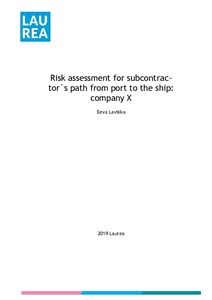Risk assessment for subcontractor´s path from port to the ship: company X
Lavikka, Eeva (2019)
Lavikka, Eeva
2019
All rights reserved. This publication is copyrighted. You may download, display and print it for Your own personal use. Commercial use is prohibited.
Julkaisun pysyvä osoite on
https://urn.fi/URN:NBN:fi:amk-201905088269
https://urn.fi/URN:NBN:fi:amk-201905088269
Tiivistelmä
The purpose of this thesis was to recognize, identify and assess risks occur from an European ship-ping company X using subcontractors. Such risk assessment is beneficial since it helps the case company to develop their overall security and safety on board. Risk assessment is crucial, since existing risks must be identified and assessed before measures to mitigate or manage risks.
The research method of this thesis was qualitative research, since the number of interviewees were only eight. Needed information regarding this research was so detailed, that qualitative re-search was the only rational method to guarantee such specific results.
As a result, there were nine (9) risks assessed in total. Risks were related to either the security check process or occupational safety. Recommendations provided detailed risk treatment methods for certain risks, and the PDCA-model was suggested in order to ensure a continuous and compre-hensive risk management process.
This thesis provides tools for the risk assessment, but it covers only risks related to the subcontrac-tors. It doesn’t apply for the overall security and safety on board but can be used by the case company if desired.
For the further development, the writer recommends the case company to construct a continuous risk management process, where both internal and external risks are managed in the continually changing environment.
The research method of this thesis was qualitative research, since the number of interviewees were only eight. Needed information regarding this research was so detailed, that qualitative re-search was the only rational method to guarantee such specific results.
As a result, there were nine (9) risks assessed in total. Risks were related to either the security check process or occupational safety. Recommendations provided detailed risk treatment methods for certain risks, and the PDCA-model was suggested in order to ensure a continuous and compre-hensive risk management process.
This thesis provides tools for the risk assessment, but it covers only risks related to the subcontrac-tors. It doesn’t apply for the overall security and safety on board but can be used by the case company if desired.
For the further development, the writer recommends the case company to construct a continuous risk management process, where both internal and external risks are managed in the continually changing environment.
